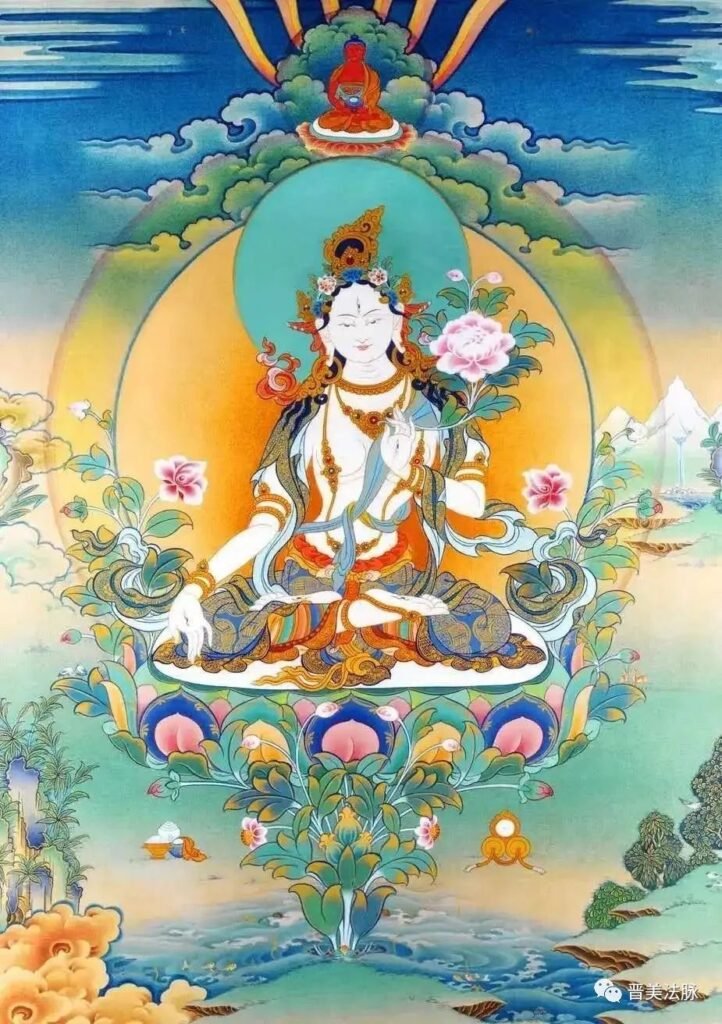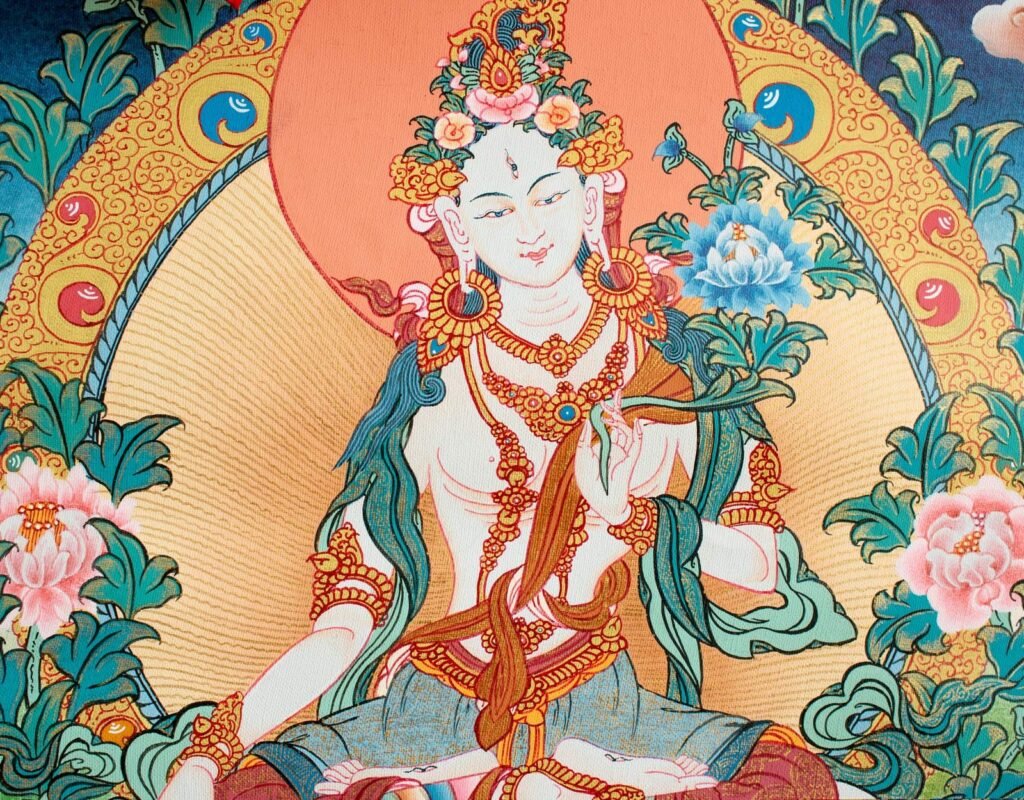White Tara: The Beacon of Longevity and Wisdom
White Tara, known as Dolkar ((སྒྲོལ་དཀར།) in Tibetan, is another manifestation of the Female deity Tara and is revered by Tibetan people, much like Green Tara. According to legend, Avalokiteśvara Bodhisattva, also known as Chenrezig, sought to benefit sentient beings innumerable eons ago. However, despite relentless efforts, he couldn’t save all beings, which filled him with compassion and made him shed tears. These tears transformed into lotus flowers. His right tear manifested as Green Tara, and his left tear became White Tara. She vowed to assist Avalokiteśvara by saying, “I pledge to aid you, and even if sentient beings are countless, my commitment remains immeasurable.” This is the origin story of White Tara.

Another belief is that White Tara emanated from Avalokiteshvara Bodhisattva’s eye consciousness, representing one of the compassionate methods he employed to save sentient beings.
Practice and Benefits of White Tara
In the eyes of Tibetan people, White Tara is a goddess of longevity, often grouped with Amitayus Buddha and Usnishavijaya as the “Three Longevity Deities.” She symbolizes long life, wealth, and beauty. Highly revered in Tibetan Buddhism, she is the main deity for many prominent figures, including Je Tsongkhapa. Her practice is a source of blessings and a focal point for people’s aspirations. Among the various practices and rituals dedicated to different forms of Tara in Tibetan Buddhism, the White Tara practice stands out as one of the most extensive and widely followed.
Prayers of White Tara
Devotion to White Tara involves the practice of her sacred rituals, believed to break the cycle of birth and rebirth, alleviate sufferings, including the eight great fears, epidemics, and illnesses, and dispel demonic obstacles. Chanting her mantra “Om Tare Tuttare Ture Mama Ayur Jnana Punye Pushtim Kuru Soha” is said to enhance wisdom, merit, longevity, and fulfill all desires. Her gentle, intelligent nature, wherein no secrets can be hidden, makes her a compassionate and eager savior in times of need.
White Tara, across different traditions, shares some common characteristics and practices, despite slight differences in her visual representation and methods of practice. A key feature shared among these traditions is the white eight-spoked wish-fulfilling wheel, composed of White Tara’s eight seed syllables “ta re tu tta re tu re swaha” (Tibetan: ཏཱ་རེ་ཏཱཏྟཱ་རེ་ཏུ་རེ་སྭཱ།). This wheel and the seed syllables are considered fundamental to her depiction and are also known as the wish-fulfilling wheel Tara. The seed syllables, each representing an aspect of life and wisdom, emanate pure white light, symbolizing purification and the enlightenment of all sentient beings.
In addition to the eight seed syllables wheel, there’s a common mantra associated with White Tara: “Om tare tuttare ture mama ayur punye jnana pushtim kuru svaha” (Tibetan: ཨོཾ་ཏཱ་རེ་ཏཱཏྟཱ་རེ་ཏུ་རེ་མ་མ་ཨཱ་ཡུ་པུཎྱེ་ཛཱན་པུཥྜིཾ་ཀུ་རུ་སྭཱ་ཧཱ།). This mantra is recited with the intent to bring longevity, strength, health, and to clear obstacles and negative influences

Iconography of White Tara in Thangkas
In Thangka paintings, White Tara is depicted with a serene, graceful demeanor, embodying tranquility and peace. Her attributes include:
- Crown and Facial Features: She wears a jeweled crown; her eyebrows are like crescent moons, with long, slender eyes, a straight nose, and small lips. Her hair is partially tied up, with some flowing down her shoulders.
- Body and Posture: Her body, radiant in white, symbolizes purity and harmony. She is adorned in multi-colored celestial robes and various ornaments like earrings, bracelets, rings, armlets, and anklets. Her right hand is in the gesture of giving, while her left holds a blue lotus (Utpala) symbolizing purity.
- Threefold Lotus: The lotus in her left hand bears three blossoms, representing the Three Jewels of Buddhism – the Buddha, Dharma, and Sangha.
- Seven Eyes: Unique to White Tara is the presence of seven eyes – three on her face (including the forehead) and one on each palm and foot sole, symbolizing her vigilant compassion towards all beings.
- Seated Posture: She sits in full lotus posture on a lotus moon disc, signifying her complete transcendence over worldly sufferings.

Atisha’s Tradition of White Tara:
- Appearance: White Tara is depicted as a sixteen-year-old girl, pure and flawless, with a complexion as white as a snow mountain.
- Features: She has one face and two arms, with a face like the autumn moon, radiating compassion and beauty, and a joyful expression.
- Unique Aspects: Seven eyes are present – one on each palm, one on each foot, and three on the face, symbolizing the “Seven Wisdom Eyes.”
- Adornments: She wears a five-wisdom crown, and her hair is partly tied up on top and partly falls over her shoulders.
- Posture: White Tara sits in the vajra position on a lotus and moon seat adorned with golden color and red lotuses, backed by a moon disk.
- Garments and Ornaments: She is draped in a green shawl with a red ribbon hanging diagonally from the right shoulder to the waist, tied in front of the navel. She holds an Utpala flower with an open bloom and a bud.
- Jewelry: She is adorned with various jewels on her ears, neck, hands, and legs.This form of White Tara, as taught by Atisha, is a central figure for meditation and practice among followers. It has become popular for seeking well-being and longevity.
Bari Lotsawa Rinchen Drak’s Tradition of White TARA:
Translator Bari Lotsawa Rinchen Drak (1040-1111): A renowned Tibetan translator and teacher, contemporary of Milarepa, and teacher to Sachen Kunga Nyingpo. He translated many Buddhist texts, including practices related to Tara.
- Appearance of White Tara: She emerges from a treasure vase representing an infinite palace. This vase has a broad base and a long neck.
- Features: White Tara in this tradition has one face and two eyes, sitting in the vajra position on a multicolored lotus and moon seat, backed by a moon disk and auspicious clouds.
- Adornments: She wears a red shawl and holds an Utpala flower with a bloom, a bud, and a fruit.
- Hair: Her hair is styled in a topknot.
White Tara’s Role in Promoting Health and Longevity
White Tara, with her serene presence and compassionate gaze, is a prominent figure in Tibetan Buddhism, embodying the virtues of health, longevity, and wisdom. Her practice is especially revered for promoting physical and spiritual well-being, making her an essential deity in the pantheon of Tibetan Buddhist worship. Her beautiful, radiant form in Thangka art serves as a reminder of the enduring qualities of life, compassion, and spiritual growth.
While the depiction of White Tara sitting on a multicolored lotus with a green shawl and holding an Utpala flower is common, there are also variations like the three-faced and six-armed White Tara (Tibetan: སྒྲོལ་དཀར་ཞལ་གསུམ་ཕྱག་དྲུག་མ།). This form represents her at sixteen years of age, with one white, one blue, and one yellow face, each with three eyes. Her hands are in various mudras and hold different symbolic objects.
Furthermore, the cultural aspects of White Tara have expanded, leading to various forms like the “Tara Who Redeems from Death,” “Tara Who Grants Longevity,” “Tara Who Increases Lifespan,” and “Tara of All Mothers,” each with their unique functions and symbolic meanings.
Despite the diversity in her representations, the core significance of White Tara in Tibetan Buddhism remains consistent: she is venerated for her ability to remove sickness, prevent premature death, and increase longevity and wisdom. Considered a goddess of longevity, wisdom, and beauty, she is revered for her power to gather the essences of the five elements, life, authority, fortune, and wisdom.
The practices and rituals associated with White Tara are numerous, reflecting people’s desire for a healthy and long life. White Tara practice emphasizes the principle of karma and the importance of cherishing all life forms as a means to longevity. This perspective has led to profound respect for White Tara in Tibetan culture.
Tara, the Savior from the Eight Great Dangers: An Exploration of the Beloved Bodhisattva in Tibetan Buddhism
Understanding Tara: The Compassionate Savior in Tibetan Buddhism
Tara, revered as one of the emanations of Avalokiteshvara (the Bodhisattva of Compassion) in Tibetan Buddhism, holds a place of special veneration. Known as the “Savior from the Eight Great Dangers,” Tara is believed to protect from perils caused by lions, elephants, serpents, water, fire, thieves, non-humans (like demons and spirits), and imprisonment. In Vajrayana Buddhism, she is also seen as a protector from all forms of disasters and as a reliever of fear and suffering. Tara is particularly venerated for ensuring smooth progress and enhancing longevity and fortune.
Depiction of Green Tara Amidst the World’s Turmoil
In Thangka paintings, Green Tara is often depicted seated amidst the chaos of the world. Although Green Tara typically symbolizes great wisdom, she is often portrayed in golden color as a special form of reverence in Thangkas. This depiction extends to other forms of Tara that save from the eight dangers. Above the main figure is Amitabha Buddha, seated in meditation posture on a lotus.
The Eight Taras: Protectors from Each Peril
Each of the eight Taras surrounding Amitabha Buddha represents protection from a specific danger:
- To Amitabha’s right is the Tara who saves from lion-related dangers, symbolizing pride.
- To his left is the Tara who protects from the perils of ignorance, represented by elephants.
- Below the main figure to the left is the Tara who saves from water-related dangers, seen praying for relief.
- Directly below is the Tara protecting devotees from non-human threats, depicted fending off a red demon.
- To the right is the Tara who shields from serpent dangers.
- The Thangka also features Taras who save from imprisonment and fire dangers.
The Twenty-One Taras: Manifestations of Compassion
The Twenty-One Taras, all female Bodhisattvas, are closely linked with Avalokiteshvara, considered emanations of his compassionate nature. This connection endows them with an esteemed and sacred status. The practice of the Twenty-One Taras is widespread across various Tibetan Buddhist sects, with many artistic representations and images stemming from the masters’ meditative experiences and visions. These Taras are commonly recited by monks and nuns as part of their initial religious studies.
Practices and Significance
Most Tibetan Buddhist monasteries conduct monthly or more frequent rituals dedicated to the Twenty-One Taras. This practice involves reciting the praises of the Taras and chanting their mantras, believed to break the cycle of rebirth and lead to rebirth in the Western Paradise. Tibetan families often request these rituals during significant life events like relocation, business ventures, or childbirth, invoking health, auspiciousness, and protection.
Central Depiction of Green Tara in Thangkas
In Thangka art, Green Tara, the central figure among the Twenty-One Taras, is depicted as a youthful woman with a serene expression. Her right hand is in a gesture of granting wishes, and her left hand holds a blue lotus, symbolizing purity and power. Her iconography includes:
- Crown and Adornments: She is crowned and beautifully adorned with jewelry.
- Posture: Her right leg is extended, signifying active engagement in the world, while her left leg is folded, reflecting her meditative nature.
- Surrounding Taras: The other twenty Taras are depicted with unique attributes but share common features, such as holding a lotus and a vase of amrita (nectar of immortality).

